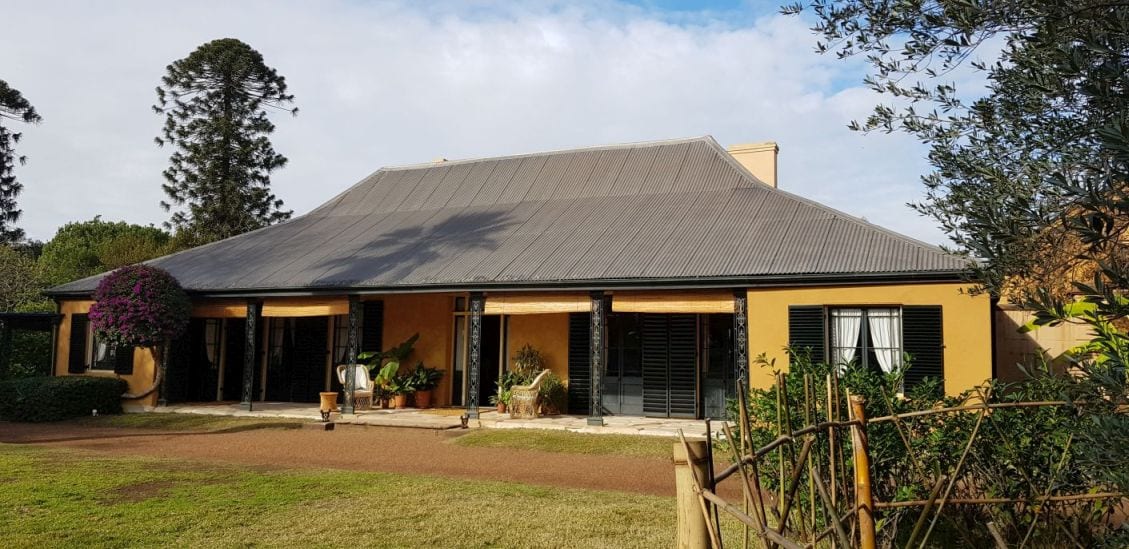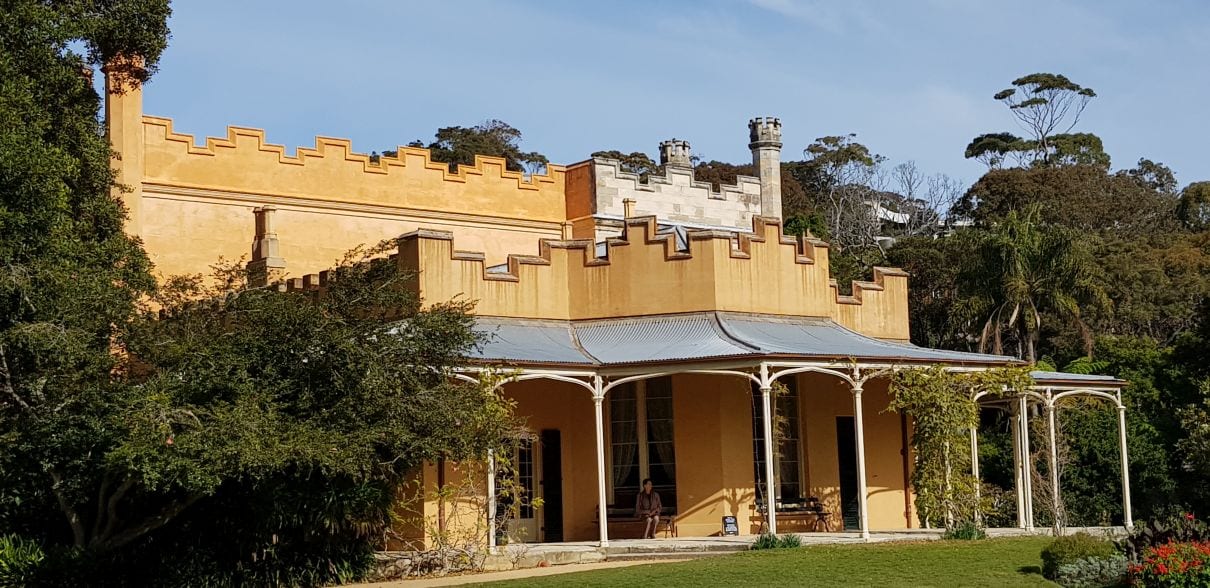
1810-1821 Major-General Lachlan Macquarie

Elizabeth Farm
Reconstruction on site
Roger Spencer – 28 June 2018
Introduction – Lachlan Macquarie
Major-General Lachlan Macquarie served as the fifth Governor of New South Wales from 1810 to 1821, and had a leading role in the social, economic, and architectural development of the colony. He is considered by historians to have had a crucial influence on the transition of New South Wales from a penal colony to a free settlement and therefore to have played a major role in the shaping of Australian society in the early nineteenth century.
Elizabeth Farm
John Macarthur (1767-1834), a lieutenant of the New South Wales Corps, had arrived in Australia with the Second Fleet in 1790. In 1793 he was given a 40 ha land grant with a fine brick house on the Parramatta River which was surrounded by a vineyard, orchard, and 1.2 ha vegetable garden. The garden expanded to 400 ha and became one of several properties owned by perhaps the most influential stock and landholder in the colony, promoted to captain in 1795.
Elizabeth Farm today is a replica of the old building with little of the original site remaining except for an olive tree, possibly the oldest remaining cultivated tree in Australia, planted perhaps as early as 1805 (but no later than 1817).
A fiery but industrious personality Macarthur was returned to England in 1801 for dueling only to return in 1805 with a flock of Spanish sheep from the royal flock, purchasing 2025 acres of land southwest of Sydney to build an estate he called Camden Park. Exiled once again between 1809 and 1817 for his role in the deposing of Bligh as Governor, be returned yet again, having toured France and Switzerland researching vinyards and agricultural practice. Among his many plant introductions new to the colony were Cork Oak, Quercus suber, and China Rose, Rosa chinensis.
Elizabeth Bay House
In 1810 Elizabeth Macquarie, wife of the new Governor Macquarie took charge of their new land to introduce winding paths and landscape features to enhance and compliment the surroundings. There were a few other examples of ‘landscaped’ gardens but until the late 1820s gardening was militaristic and functional, gradually softening with the development of civil society, pastoral wealth and official sanction of ‘villa allotments’. By the 1830s a measure of affluence permitted the display of ‘taste’ as exemplified by the Colonial Secretary Alexander McCleay with his gardens at Elizabeth Bay and Brownlow Hill, and pastoralist William Macarthur at Camden Park. These gentlemen were able to indulge the gardenesque style of the 1830s – the ‘Gardenesque’ (plants separated to display their individual attributes), promoted by their highly influential mutual Scottish friend John Claudius Loudon. This style was emulated both in New South Wales and the other colonies although the smaller gardens continued to be mostly rectilinear and symmetric.
Vaucluse House
Sir Hayes took to farming and the ‘ gentleman convict turned gentleman farmer’ also built a house there called Vaucluse House. Elizabeth Bay House is the most elegant and sophisticated house of the 1830s in New South Wales. Alexander Macleay, who arrived in Sydney in 1826 with his wife and six daughters. The Macleays’ interests included entomology, horticulture, landscape design, architecture, natural history illustration and fine art. of poor girls as servants.

Vaucluse House
Roger Spencer – 1 July 2018
Macleay developed Elizabeth Bay as a celebrated landscape garden. The site of the house was chosen for its vistas across Sydney Harbour. The native bush was retained and planted with exotics to enhance its botanical interest and the dramatic topography was embellished with picturesque structures: a turretted stables, cottages, a rustic bridge, terrace walls and grottoes. Macleay’s development of his garden reveals his informed taste and romantic enthusiasm. Macleay’s approach to the Australian bush was in contrast with that of the majority of colonists, who customarily cleared it and started afresh. The bush was planted with specimen orchids and ferns to enhance its botanical interest, which could be enjoyed in the course of a ‘wood walk’. Two notebooks survive – partly in the hand of Alexander and partly in the hand of William Sharp Macleay – Plants Received at Elizabeth Bay, c 1826-1840, and Seeds Received at Elizabeth Bay, 1836-1857. These list the sources of plants for the Elizabeth Bay garden and illustrate a comprehensive approach to plant collecting, similar to their approach to entomology. The plant and seed books contain entries for purchases from the nurserymen Messrs Loddiges of Hackney, London and exchanges with William Macarthur of Camden. They also record the plants contributed by visitors to the Elizabeth Bay estate and by William Sharp Macleay’s natural history collectors in India. Macleay’s garden was notable for its fruit trees. Many visitors also remarked on Macleay’s achievement in creating a garden in what some people believed to be Sydney’s dry conditions and sandy soil. The Elizabeth Bay estate was progressively lost to subdivisions.
The Governors garden, later the RBG Sydney c.1816, was a means of introducing useful plants to the colony.
Plant history
During the administration of Lachlan Macquarie in Australia from 1810 to 1821, agriculture, horticulture, gardening, and forestry played crucial roles in the development of the colony. Macquarie’s tenure as Governor marked a significant period of growth and transformation in these sectors, with a focus on improving food production, beautification of settlements, and sustainable land management practices. The relationship between plants and people during this time was one of mutual dependence and exploitation, as settlers sought to harness the land’s resources for their own benefit while also recognizing the importance of sustainable practices for future generations.
Agriculture was a cornerstone of the colonial economy in early 19th-century Australia, with a focus on producing food for the growing population of settlers and convicts. Macquarie implemented policies to encourage agricultural development, including granting land to settlers for farming and providing incentives for the cultivation of crops such as wheat, maize, and vegetables. The introduction of new farming techniques and crop varieties helped to increase productivity and improve food security in the colony.
Horticulture and gardening also played important roles in the development of early Australian settlements during Macquarie’s administration. Macquarie had a keen interest in landscaping and beautification, and he encouraged the planting of gardens and ornamental trees in towns and villages. Botanical gardens were established in Sydney and other major settlements, showcasing a wide variety of plant species from Australia and around the world. These gardens served as both recreational spaces for residents and as centers for the study and propagation of new plant species.
Forestry was another key aspect of land management during Macquarie’s administration, as the demand for timber for construction and fuel was high in the growing colony. Macquarie implemented policies to regulate the cutting of trees and promote sustainable forestry practices, including the establishment of timber reserves and the replanting of trees in cleared areas. These efforts helped to ensure a steady supply of timber for the colony’s needs while also preserving the natural environment for future generations.
The relationship between plants and people during this period was complex and multifaceted. Settlers relied on plants for food, shelter, and fuel, and they often exploited the land’s resources for their own benefit. At the same time, there was a growing awareness of the need to manage the land sustainably and to conserve its natural resources for future generations. Macquarie’s administration sought to strike a balance between these competing interests, promoting agricultural and forestry practices that would meet the colony’s immediate needs while also ensuring the long-term health of the land.
One of the key challenges faced by early settlers in Australia was the harsh and unpredictable climate, which could make agriculture and horticulture difficult. Droughts, floods, and other natural disasters could devastate crops and gardens, leading to food shortages and economic hardship. Macquarie worked to mitigate these risks by promoting irrigation schemes, introducing drought-resistant crop varieties, and encouraging the adoption of sustainable farming practices. These efforts helped to make agriculture more resilient in the face of environmental challenges and paved the way for future developments in land management and food production.
The introduction of new plant species from around the world also had a significant impact on the relationship between plants and people in early colonial Australia. European settlers brought with them a wide variety of crops, fruits, and ornamental plants, which were cultivated in gardens and farms across the colony. These new species not only provided food and resources for the settlers but also transformed the landscape, creating a rich tapestry of colors and textures that reflected the diversity of the natural world.
In conclusion, the administration of Lachlan Macquarie in Australia from 1810 to 1821 was a period of significant growth and development in agriculture, horticulture, gardening, and forestry. Macquarie’s policies and initiatives helped to promote sustainable land management practices, improve food production, and beautify the colony’s settlements. The relationship between plants and people during this time was one of mutual dependence and exploitation, as settlers sought to harness the land’s resources for their own benefit while also recognizing the importance of conservation and sustainability. Macquarie’s legacy in these sectors laid the foundation for the continued growth and prosperity of Australia’s agricultural and horticultural industries in the years to come (AI-GPT-4o June 2024).
-
-
- 1810: Lachlan Macquarie becomes Governor of New South Wales, Australia.
- Macquarie implements policies to encourage agricultural development, including granting land to settlers for farming and promoting the cultivation of crops such as wheat, maize, and vegetables.
- Horticultural and gardening initiatives are introduced, with Macquarie encouraging the planting of gardens and ornamental trees in towns and villages.
- Botanical gardens are established in Sydney and other major settlements, showcasing a wide variety of plant species from Australia and around the world.
- Forestry policies are implemented to regulate the cutting of trees and promote sustainable forestry practices, including the establishment of timber reserves and replanting efforts.
- Macquarie works to mitigate environmental challenges such as droughts and floods by promoting irrigation schemes, introducing drought-resistant crop varieties, and encouraging sustainable farming practices.
- Lachlan Macquarie’s administration comes to an end, leaving a legacy of agricultural and horticultural development in colonial Australia.
-

